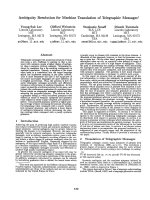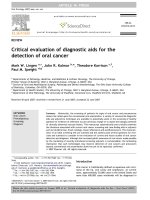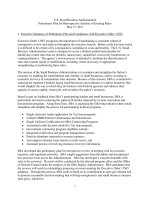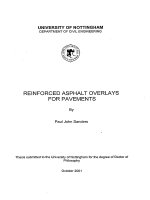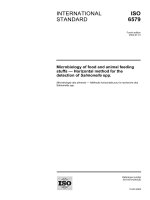REINFORCED ASPHALT OVERLAYS FOR PAVEMENTS - UNIVERSITY OF NOTTINGHAM DEPARTMENT OF CIVIL ENGINEERING doc
Bạn đang xem bản rút gọn của tài liệu. Xem và tải ngay bản đầy đủ của tài liệu tại đây (25.25 MB, 381 trang )
UNIVERSITY OF NOTTINGHAM
DEPARTMENT OF CIVIL ENGINEERING
REINFORCED ASPHALT OVERLAYS
FOR PAVEMENTS
By
Paul John Sanders
Thesis submitted to the University of Nottingham for the degree of Doctor of
Philosophy
October 2001
To my family.
Thank you for the sacrifices you have made to give me the
freedom to undertake this work.
11
ABSTRACT
The maintenance of road pavements in England has become a costly
necessity, due largely to the large volume of commercial vehicles using the
roads which cause pavements to deteriorate quickly, and makes their repair
more difficult to carry out. These roadworks incur not only direct works costs,
but also indirect costs from factors such as congestion, motor accidents and
pollution. There is obviously a need for cost-effective maintenance that
minimises the occurrence and duration of these disruptions.
To strengthen pavements bituminous overlays are often used, but may crack
prematurely when placed over a layer with discontinuities such as cracks or
joints, or deform excessively under wheel loading. The problem of 'reflective
cracking' is widespread and reduces the life of maintenance treatments
considerably. To increase the time before cracking appears on the surface of
a pavement, a (more expensive) thicker overlay may be used, but this can
lead to problems with property thresholds and bridge clearance. One possible
option of reducing the thickness of overlays by making them more resistant
against cracking and deformation, is to place a layer-of reinforcement within or
at the bottom of the overlay. Although this approach has been used
occasionally to reinforce overlays, over 40 years or so, it is not favoured with
many road authorities, as the results of these treatments are difficult to
anticipate, and may not be cost effective.
This thesis describes an investigation into the effect of reinforcing thin
bituminous overlays to identify key factors that significantly influence their
performance. By identifying these factors, optimum use of reinforced asphalt
should be possible, and thus maintenance of the road network made more
cost effective.
The investigation was principally carried out in the laboratory using beam
tests, shear box tests, tensile tests on reinforcement and large-scale wheel
tracking tests. 2-D Finite Element Analysis was used in the analysis of test
results.
Results show that properly constructed reinforced overlays can be between
two or three times more resistant to cracking, and have less than half the
permanent deformation of unreinforced materials.
ACKNOWLEDGEMENTS
I would like to thank all those who have contributed to the research, whether it
be by providing assistance, encouragement, advice or funding.
In particular, I wish to thank the following individuals and organisations:
Professor S. F. Brown and Dr N Thom, my supervisors, for their help and
guidance, throughout the work.
The laboratory staff at the university, especially Andy Leyko, Barry Broderick,
Shane Malkin, Ehsan Sharegh and Mick Hutchings.
The research consortium that included Netlon Ltd, ABG Ltd, 6-D Solutions,
Maccaferri Ltd, Scott Wilson Pavement Engineering and Bardon Roadstone
(now Aggregate Industries UK Ltd).
The Engineering and Physical Sciences Research Council (EPSRC) for the
majority of the funding.
iv
DECLARATION
The laboratory work described in this thesis was conducted at the University
of Nottingham Department of Civil Engineering between December 1995 and
April 2000. Subsequent to the laboratory work, much of the analysis has
been carried out at my home in Berkshire.
I declare that this work is my own and has not been submitted for a degree at
another university.
Paul Sanders
\
ý3 ,.
.ýýrA1ýý; ý
V
ýýý
\
TABLE OF CONTENTS
Abstract
Acknowledgements
Declaration
Table of contents
Chapter 1
Introduction
Chapter 2
Problem definition - Desk Study
Chapter 3
Literature Review
Chapter 4
Project Strategy
Chapter 5
Tests on Reinforcement Materials
Chapter 6
Cyclic Shear Box Testing
Chapter 7
Beam Testing
Chapter 8
Pavement Test Facility
Chapter 9
Numerical Modelling - Finite Element Analysis
Chapter 10
Economic Appraisal: Whole Life Costing
Chapter 11
Guidelines for Design
Chapter 12
Summary and Overall Conclusions
Chapter 13
Proposals for Future Work.
vi
Chapter 1- Introduction
CHAPTER I
INTRODUCTION
CONTENTS
1.1
General
1.2
Pavement Failure Mechanisms
1.2.1
.............................................................................................
General
.........................................................
...........................................................................................
1.2.2
Fatigue Cracking
1.2.3
Reflection Cracking
1.2.4
Rutting
1.2.5
Field Mechanisms
............................................................................
........................................................................
............................................................................................
.........................................................................
1-2
1-4
1-4
1-4
1-5
1-6
1-6
1-7
1.3
Maintenance treatments
1.4
Aims of the Project
............................................................................
1-9
1.5
Structure of the Thesis
......................................................................
1-9
1.6
References
1-11
...................................................................
.......................................................................................
Chapter 1- Introduction
1
INTRODUCTION
1.1
General
For an economy to be successful and efficient, a freely flowing transportation
network is important. In Britain, over the past half century or so, industry has
increasingly used the road network to fulfil this function, with rail and waterways
becoming less well-used. However, as traffic levels continue to rise, the road
network is becoming less able to fulfil the needs of the economy, which in turn leads
to (interalia) more expensive goods and services and environmental damage.
To relieve the general problem of traffic congestion, the historical approach has
been to build new roads. However, this is now becoming less desirable, less
economic and less environmentally acceptable in Britain and most other developed
countries. Unless traffic levels are reduced, therefore, it follows that road congestion
will not be relieved and will probably increase as the road network increased travel
times, traffic delays, increased pollution and enforced lower speed limits (for safety
reasons).
From the above, it is appears that maintenance measures to arrest or delay road
deterioration are required and should be quick to implement and long-lasting. These
help to reduce traffic congestion by both keeping the works period as short as
possible and by increasing the period between maintenance treatments. An added
incentive for more effective (long-term) maintenance is the lengthening back-log of
road maintenance as a result of a reduction in funding in recent years [1.1,1.2,1.3,
This reduction of maintenance budgets has led to some lengths of
1.4,1.5,1.6].
pavement requiring a structural treatment only receiving a superficial treatment, to
ensure safety is not compromised. The effect of postponing structural maintenance
in the short term is often an increase in the cost required to bring and maintain the
to an acceptable standard in the longer term. This problem has been
road network
recognised by the UK Highways Agency (HA) who are now committed to evaluation
highway construction and maintenance in terms of Whole Life Costs [1.7], an
of
approach that facilitates comparison of different construction and maintenance
options. The need for quick and effective maintenance treatments has also been
the advent of long-term Design, Build, Finance and Operate
emphasised with
(DBFO) contracts, where efficient maintenance strategies can make the difference
between success and failure.
At present the most commonly used maintenance treatments include
surface dressings
a)
b)
thin wearing courses
inlays,
c)
d)
resurfacing,
e)
overlays
f)
partial or full reconstruction.
In terms of their classification, a) and b) are not considered structural maintenance
treatments, c) and d) may be considered as enhancing the pavement structure, but
e) and f) increase the structural capacity of a pavement.
Chapter 1- Introduction
Where a pavement structure requires strengthening, options to reduce overlay
thicknesses are desirable for protection of the environment, and economy, i.e. to
reduce the quarrying of aggregates, and to provide a pavement with adequate
performance at reduced cost. One approach to achieve this, that has been used to
a limited degree over the past 50 years or so, is asphalt `reinforcement" i.e. the
inclusion of interlayer materials placed typically between an existing pavement and
the overlay. As described in Chapters 2 and 3 (the Desk Study), a range of
materials are commercially available that reputedly reduce rutting and/or cracking.
These include grids, fabrics and composites (having elements of both grids and
fabrics), which may comprise plastic, glass or steel. As will be later seen, the option
of asphalt reinforcement is not a straightforward option, and the significantly different
nature of some of these materials (produced to combat the 'same' defect or defects)
is indicative of problems in (i) characterising the nature and causes of cracking, and
(ii) providing a solution to the problems.
Historically, limited use of grids and fabrics has been made if compared to other
approaches such as partial reconstruction or thicker overlays. This is so for a
number of reasons that have contributed to the general lack of confidence in their
abilities. It follows then that highway authorities are understandably reluctant to give
approval to maintenance treatments that have a relatively short (if any) track record
in the UK. This in turn makes it more difficult for performance data to be
accumulated. Accordingly, maintenance treatments using grids or fabrics are more
often found on county roads than on trunk roads, whereas other more conventional
solutions such as thicker overlays and bituminous mixtures incorporating modified
binders, for instance, are usually adopted in preference on the trunk road and
motorway network. Another reason for the lack in confidence in using reinforced
asphalt stems from reluctance to use it on the part of contractors, who, during
construction, may encounter difficulties if they are not experienced in laying grids
and fabrics.
A brief investigation of the market relevance of the project shows that the current UK
use of asphalt pavement interlayers (grids and fabrics) has an annual value of
around 2.5 million pounds. To be more meaningful, however, this figure needs to be
considered with savings made due to reduced overlay thicknesses, or treatments
resulting in fewer interventions in the future. When considered in the light of the
budget for structural maintenance of the Motorway and Trunk Road network of
approximately 250 million pounds, it is understandable that it is still seen as a small
market niche by manufacturers. However, the market is likely to grow substantially
as the need for more cost-effective maintenance and alternatives to pavement
reconstruction increases.
' Note that for the purposes of this document, the term 'reinforced
asphalt' refers to asphalt layers
that include grids and fabrics, and not fibre-reinforced materials.
1-3
Chapter 1- Introduction
1.2
Pavement Failure Mechanisms
1.2.1 General
It follows that before effective pavement treatments can be devised and evaluated,
an understanding of the way in which pavements fail is required. For brevity, the
following discussion is restricted to the main modes of failure of bituminous surfaced
roads, which include fully flexible pavements, flexible composite pavements and
overlaid rigid pavements. These structures are shown in Figure 1.1.
Typically, pavements 'fail' in serviceability by developing poor riding quality
(manifested by driver discomfort and measured by longitudinal or transverse
unevenness), or becoming unsafe, particularly through reduced skidding resistance.
The deterioration of riding quality of a pavement is measured as unevenness of the
surface which may be due to permanent deformation of bound materials or
differential settlement of supporting layers. An unsafe pavement on the other hand is
normally one with poor skidding resistance. This occurs when the pavement surface
is made smooth by the passage of traffic, an excess of bitumen in the surface
(bleeding), or standing water. Apart from an obvious design or construction fault with
surface levels, ponding of surface water occurs in ruts, or is due to the settlement of
the pavement support.
Apart from loss of skid resistance the two most common symptoms of 'failure' of
bituminous-surfaced roads are rutting and cracking, and these are discussed in
more detail below. As a general comment it is noted that 'failure' of pavements
relates almost always to that of serviceability and not of 'destruction' as might be the
case with other engineering structures.
Cracking affects pavements detrimentally in various ways. Initially, layer strength is
lost which leads to overstressing of lower layers, consolidation and as a
permanent deformation. In addition to the reduction in strength (due
consequence,
to less intact material), cracks provide access for water which softens unbound
materials and reduces shear strength.
Cracks and permanent deformation are normally attributed to traffic and/or
influences. However, aspects of construction may also help induce
environmental
problems such as when carriageways are widened. For instance, cracking may
the junction of old and new constructions as a result of differential
occur at
deflections across the vertical interface, which are due to differences in support of
the old and new constructions. The principal crack types associated with pavements
are now described.
1.2.2 Fatigue Cracking
Fatigue cracking occurs due to repeated applications of tensile strain which
eventually overcome the resistance of the material. This phenomenon may be
considered as having two phases: (i) initiation and (ii) propagation. Crack initiation
can be considered as where the repeated application of tensile strains cause microcracks to join and form a macro-crack. The continued application of tensile strains
then causes growth and progression of this macro-crack through the material, which
is known as the propagation phase.
1-4
Chapter 1- Introduction
then causes growth and progression of this macro-crack through the material, which
is known as the propagation phase.
Crack initiation has been relatively well investigated and defined through functions
that relate tensile strain to number of load repetitions (see References 1.8 and 1.9
for example). Crack propagation on the other hand is less understood and defined
and is influenced by factors such as
the type and amount of bitumen in the mixture,
"
the amount and type of aggregate present,
"
adhesion of the bituminous binder to the aggregate [1.10]
"
the nature of applied load (traffic and environmental).
"
Some of these factors are difficult to quantify and so present problems in predicting
performance.
The three main modes of crack propagation which may be considered are shown in
Figure 1.2, and are termed:
Mode I
Mode II
Mode III
(opening mode)
(shearing mode) and
(a 'tearing' mode),
In practice Mode I cracking could be expected at the bottom interface of a bound
pavement layer when loaded, and Mode II cracking might be expected in material
bridging a crack or joint subject to differential movement. Mode III cracking is
perhaps more difficult to visualise but could possibly occur adjacent to wheel loads
(longitudinally) in a pavement.
In the classical pavement bending mode, crack initiation is normally expected to
occur at the lower interface of a layer, although in thick bituminous layers (typically in
excess of 250mm [1.11] as are found on many of Britain's trunk roads and
motorways), cracking has often been found as a top-down phenomenon. Also,
where pavements have rutted, longitudinal cracks may be found adjacent to the
'shoulders'. These modes of pavement behaviour are illustrated in Figure 1.3.
1.2.3 Reflection Cracking
Mechanisms of reflection cracking are complex and can be due to a
combination of the movement of joints or discontinuities in the pavement beneath an
overlay, and environmental influences at the pavement surface. In general, the main
contributor to vertical movement of cracks or joints is taken to be traffic loading.
Horizontal movements are assumed to be caused by differential thermal expansion
and contraction of the pavement layers. The magnitude of vertical movements
depends on a range of factors including support to the layer being cracked and
roughness of the crack faces (interlock). For thermal loading on the other hand, the
severity of temperature gradients through the layers, plus the coefficient of thermal
expansion/contraction of the different materials are of prime importance. More
detailed descriptions of reflective cracking are to be found in proceedings of the 4
RILEM conferences [1.12,1.13,1.14,1.15] and De Bondt [1.16].
Chapter 1- Introduction
Notwithstanding the considerable work carried out to characterise and solve
reflective cracking problems, mechanisms still remain somewhat undefined. For
instance, reflective cracking occurring in Lane 2 but not on the adjacent Lanes
(Lanes 3 and 1) or on the hard-shoulder (that was not trafficked) has been reported.
This type of occurrence highlights the complicated nature of predicting pavement
performance in the field, even with 'normal' pavement constructions. As described
later, the addition of non-asphaltic interlayer materials within asphalt layers serves to
give more difficulties in analysis and performance prediction.
1.2.4 Rutting
Rutting occurs as a consequence of deformation of the visco-elastic bituminous
materials and/or permanent deformation of materials supporting the bituminous
surfacing. An illustration of the stress-strain-time response of bituminous materials
is given in Figure 1.4. The permanent deformation of bituminous material is due to
viscous flow of the bitumen, which in turn is a function of loading time, stress level
and temperature. With repeated loading, permanent strains accumulate and
manifest as surface deformation, recognised typically through the appearance of
raised shoulders. Deformation of the whole pavement structure does not produce
shoulders. The two different mechanisms are illustrated in Figure 1.5.
To help prevent 'excessive' rutting, analytical flexible pavement design generally
uses relationships between traffic-induced vertical strains at the top of the subgrade,
and the accumulation of permanent deformation to determine layer thicknesses [1.8
and 1.9]. No deformation within the bituminous material is therefore explicitly taken
into account. The permanent deformation of materials supporting the bound layers
is due to excess stress being transmitted through the bound layers and is a
deficiency of the overall pavement design.
1.2.5 Field Mechanisms
The mechanisms
summarised.
by which rutting and cracking occur in the field are now
Flexible pavements may fail due to excess permanent deformation, cracking or a
combination of both. Crack formation often begins in wheel tracks, and as the
pavement becomes progressively trafficked, spreads irregularly over the surface.
Eventually, the surface may be covered in a lattice of interlocking longitudinal and
transverse cracks often termed 'alligator cracking'.
Failure of flexible composite pavements typically occurs when cracks in the
supporting cement bound (CBM) roadbase are 'mirrored' on the surface or reflect
through to the surface. At this stage, the mode of failure is typified by quite
regularly-spaced transverse cracks. Cracking of the CBM occurs through initial
shrinkage of the material (and is therefore dependant on the cement content used),
and due to daily and seasonal changes in temperature. The changes in temperature
induce contraction and expansion in materials which largely depends on the type of
aggregate used.
With prolonged or heavy trafficking, flexible composite pavements may also develop
a network of irregular cracks as the CBM gradually breaks into smaller pieces which
Chapter 1- Introduction
reflect cracks into the surfacing. It is therefore possible to estimate the degree of
distress of a CBM by the nature and severity of surface cracking.
The structural strength of the CBM usually precludes the formation of 'whole
structure' rutting, so permanent deformation observed on the surface is likely to be
due to permanent deformation of the bituminous material only.
Overlaid rigid pavements typically fail through reflective cracking, as slabs tend to
move or 'rock' under traffic loads due to support under the ends of the slabs
weakening. Surface cracks are then opened up over joints which can allow the
ingress of water. If this occurs, further loading can force water and fine material out
of the cracks which is termed 'pumping'. Pavement failure can then become very
much quicker as support is progressively reduced and rocking is intensified, which
opens cracks and gives access to more water, thus making the situation worse. With
reduced support, concrete slabs may crack irregularly, especially close to corners
and edges, which can often be seen as diagonal cracks.
1.3
Maintenance treatments
It follows therefore that any economic maintenance treatment should result in the
number of load repetitions required to initiate and subsequently propagate cracks
being increased, and the rate of permanent deformation reduced. Where overlays
are to be used there are several possible approaches to enhance their performance.
These include increasing the thickness of bituminous material, placing a Stress
Absorbing Membrane Interlayer (SAMI), modifying the properties of the overlay (by
addition of a polymer perhaps), or adding a reinforcing interlayer between the
surfacing and the cracked/jointed layer.
The options are now briefly described.
An increase in the thickness of bituminous material has two main functions,
namely, to reduce the strain on the lower interface and increase the time of crack
propagation due to the increased distance from the point of crack initiation to the
surface. This has been well-used historically but can be expensive, and is not
compatible with the increasing environmental concern. Also, in situations where no
further increase in levels can be allowed, this option is not feasible.
A SAMI is a relatively soft layer placed between the old pavement and the new
construction. The function of a SAMI is to reduce stresses generated by movement
in the cracked pavement to a level that can be accommodated by the overlay. A
SAMI is typically 4-8mm thick and often comprises a blend of rubberised bitumen. A
summary of the findings of a study into the effectiveness of SAMIs has been given
by Mukhtar and Dempsey [1.17] which (inter alia) states that SAMIs have been more
effective when used with flexible pavements than rigid pavements and that SAMIs
perform better the thicker they are and lower stiffness they have. Also, full-width
pavement treatment has been more successful than local treatment directly over the
joint/crack area.
Modified binders in bituminous mixtures [1.18] have been used for more than a
decade to improve resistance to rutting and cracking. Probably the most common
1-7
Chapter 1- Introduction
way of bitumen modification is with the addition of Styrene Butadiene Styrene (SBS),
Styrene Butadiene Rubber (SBR) or Ethylene Vinyl Acetate (EVA) polymers. The
addition of these polymers helps to enhance the performance of the bituminous
mixture at high and low temperatures, which in general means that mixtures are less
susceptible to rutting at high temperatures and cracking at low temperatures.
Design rules that can reliably quantify the subsequent performance of pavements
incorporating these materials are however not presently well-developed, and field
trials [1.19,1.20] give a range of effectiveness. Work aimed at quantifying the
properties of polymer-modified bitumen and the subsequent effects on mixture
performance is reported in Reference 1.21.
The inclusion of grids, fabrics and composites within a pavement construction is
another option that has been tried in various forms since the 1950s. Although the
first use of (steel) reinforced asphalt occurred in the 1950s, it is only in the past 20
years or so that a range of different glass and plastic materials have been used in
any significant quantity. Early work carried out at Nottingham [1.22] helped to
confirm the potential of reinforcing pavements with grids. Conventional engineering
philosophy would normally suggest that there are two main reasons for placing
interlayer materials within a pavement. First of all, if the interlayer material is stiffer
than the asphalt, it will reinforce the layer (if adequately bonded to the asphalt above
and below) by carrying load that would otherwise be carried by the pavement.
Otherwise, if the interlayer stiffness is less or of a similar magnitude to asphalt, then,
to enhance the properties of the pavement it must provide stress-relief or similar to
protect the pavement. This may also include a `crack-stitching' quality where crack
initiation is not prevented, but crack propagation is delayed.
Note that for the remainder of the document, the term 'reinforced asphalt' refers to
any sheet, grid or combination of the two, within layers of asphalt.
Although it would appear relatively simple to define which mechanism applies and
what contribution it makes to engineering performance, few reliable guidelines exist.
In fact, basic questions regarding the type of material to be used as an interlayer,
and where it should be placed in a pavement still remain. It also follows that more
detailed questions, such as the nature of the bonding (adhesion or interlock) and the
effect it has on pavement performance and how to achieve it in the field are also
poorly defined.
The main focus of the work described here was to investigate the principal factors
affecting the use and performance of reinforced asphalt. Once these factors were
defined, it was reasoned, this knowledge would be used to predict pavement
performance and make it possible to choose appropriate treatments on the basis of
sound engineering principles.
As cracking has been a major contributor to pavement failure in the past, the project
is primarily directed towards reducing or solving the problems of cracking. However,
as is later seen, the possible role for reinforcement in slowing the development of
rutting is also addressed.
It is recognised that the best method of establishing field performance is to monitor
the behaviour of full-scale in-service pavements. This of course is not feasible for
1-8
Chapter 1- Introduction
every experiment due to practical reasons such as the number of test variables
which need to be investigated which would result in excessive cost. Accelerated
testing of full-scale pavements is another option but would also be expensive even if
the apparatus was available. Physical and mathematical modelling is on the other
hand affordable and possible with the facilities at hand, and offers some advantages
over large-scale testing.
More discussion of the approach chosen to investigate
mechanisms is given in Chapter 4.
1.4
reinforced pavement
Aims of the Project.
A summary of the aims of the project is given:
"
To investigate the use of reinforced asphalt in the UK in particular, and around
the world in general.
"
To carry out tests on samples of reinforced asphalt to define operating
mechanisms.
"
"
To model laboratory test results and to apply these models to field situations
To summarise findings and produce guidelines for the selection and use of
reinforced asphalt.
1.5 Structure of the Thesis
The thesisis structured follows:
as
Chapters 2 and 3 comprise a general introduction to reinforced asphalt, how and
where it has been used, and with what success. Chapter 4 summarises the results
of the desk study and discusses possible approaches to the problem. These range
from monitoring in-situ applications of reinforced asphalt under real traffic loading, to
laboratory testing of each of the components (asphalt, reinforcement and the bond
between them).
Chapters 5 and 6 describe laboratory testing of the components of reinforced
asphalt i.e. reinforcement and interlayer bond.
In chapters 7 and 8 the development of test apparatuses used to test reinforced
asphalt beams and half-scale reinforced pavements is described. Chapter 7 gives
details on beam tests, and Chapter 8 describes wheel tracking tests.
The numerical modelling of reinforced beam and pavement structures using Finite
Element Analysis (FEA) is described in Chapter 9. The potential benefits in terms of
reducing crack propagation is illustrated.
Economic appraisal of reinforced asphalt using the Whole Life Costing (WLC)
approach is given in Chapter 10. In particular, the appraisal shows that careful
consideration of the field situation is required before reinforced asphalt will be an
economic solution to rutting or cracking.
Chapter 1- Introduction
Chapter 11 provides guidelines for the use of reinforced asphalt derived from both
work carried out in this project, and from results of full-scale trials described in the
literature.
Chapter 12 gives an overall summary and conclusions of the project, and Chapter
13 gives suggestions for future work to be carried out to investigate some of the
'unknowns' discovered during the present work.
1-10
Chapter 1- Introduction
1.6
References
1.1
NEWS, New Civil Engineer, 30 November 1995.
1.2
NEWS, New Civil Engineer 25 January 1996.
1.3
CE NEWS, New Civil Engineer, 4 July 1996.
1.4
Ty Byrd, New Civil Engineer 23 January 1997.
1.5
Government Statistical Service (1999). Transport Statistics Bulletin, National
Road Maintenance Condition Survey: 1999.
1.6
'News' World Highways, July/August 2000.
1.7
Highways Agency Business Plan 1999/2000. St Christopher House, London,
1999.
1.8
Brown, SF and Brunton, J M, (1985). An Introduction to the Analytical Design
of Bituminous Pavements (3rd Edition), Department of Civil Engineering,
University of Nottingham.
1.9
Shell International Petroleum Company Ltd (1978). Shell Pavement Design
Manual - Asphalt Pavements and Overlays for Road Traffic, Shell
International Petroleum Company Ltd London, 1978.
,
1.10
Read, JM (1996). Fatigue Cracking of Bituminous Mixtures.
Department of Civil Engineering, University of Nottingham.
Phd Thesis,
1.11 Wu, Fenghe (1992). Assessment of Residual Life of Bituminous Layers for
the Design of Pavement Strengthening. PhD thesis, Department of Civil
Engineering and Building, The Polytechnic of Wales.
1.12
RILEM, (1989). Reflective Cracking in Pavements: Assessment and Control.
Proceedings of the RILEM Conference on Reflective Cracking in Pavements,
Liege, Belgium, March 1989.
1.13
RILEM, (1993). Reflective Cracking in Pavements: State of the Art and
Design Recommendations. Proceedings of the Second RILEM Conference on
Reflective Cracking in Pavements, Liege, Belgium, 1993.
1.14
RILEM, (1996). Reflective Cracking in Pavements: Design and Performance
Overlay Systems. Proceedings of the Third International RILEM
of
Conference on Reflective Cracking in Pavements, Maastricht, Holland,
September 1996.
1.15
RILEM, (2000) Reflective Cracking in Pavements: Research Into Practice.
Proceedings of the 4th International RILEM Conference on, Ottawa, Ontario,
Canada, April 2000.
Chapter 1- Introduction
1.16 De Bondt, AH, (1999). Anti-Reflective Cracking Design of (Reinforced)
Asphaltic Overlays. PhD Thesis, Department of Civil Engineering, Technical
University of Delft, Holland.
1.17
Interlayer stress absorbing
Mukhtar, MT and Dempsey, BJ (1996).
composite (ISAC) for Mitigating Reflection Cracking in Asphalt Concrete
Overlays.
Final Report, Project IHR-533, Illinois Cooperative Highway
research Program, Department of Civil Engineering, University of Illinois at
Urbana-Champaign.
1.18
Brown, S F, Rowlett, RD and Boucher, JL (1990). Asphalt Modification.
Proceedings of a Conference on US SHRP Highway Research Programme:
Sharing the benefits. ICE London pp181-203.
1.19
Butterworth, P and Whitely, DN (1996). Report on Inspection of Modified
Surfacings: M6Birmingham to Carlisle Motorway, County Boundary to
Junction 37, NB and SB Carriageways. Highways and Engineering Division,
Civil Engineering Laboratory, Skirsgill Lane, Penrith, Cumbria.
1.20
Nunn, M. E. and Potter, J. F. (1993) Assessment of Methods to Prevent
Reflection Cracking. Proceedings of the Second RILEM Conference on
Reflective Cracking in Pavements. Reflective Cracking in Pavements: State of
the Art and Design Recommendations. Liege, Belgium, 1993 pp360-369.
1.21
Brite/Euram II, (1994). Quality Analysis of Polymer Bitumens and Bitumen
Products by Microscopy Image Analysis with Fluorescent Light. University of
Nottingham, Nottingham, UK
1.22
Hughes, DAB, (1986). Polymer Grid Reinforcement of Asphalt Pavements.
PhD Thesis, Department of Civil Engineering, University of Nottingham.
FLEXIBLE, FLEXIBLE COMPOSITE &RIGID
COMPOSITE PAVEMENTS
OVERLAID RIGID PAVEMENT
I Bituminous
n
04_
Ip
bl
Overlay
N,
I
"
11, "AIs.
Pavement Qualitv Cortcrete
ý
d-d+
-ý---u
^__,,
Sub-base
Foundation
Capping
Subgrade
PAVEMENT STRUCTURES
FIGURE 1.1 -
ýý
Mode III
Mode I
MODES OF CRACKING
FIGURE 1.2
ö
-s
(a) FATIGUE CRACKING AND CRITICAL STRAINS
1
II
II
II
I
I
1
I
BOUND
MATERIALS
GRANULAR
MATERIALS
SUBGRADE
(b)
RUTTING
AND CRACKING
FAILURE MODES AND CRITICAL STRAINS
FIGURE 1.3
Stress
ý
Time
Strain
Total Permanent
Strain
ý-->
L-4
Time
DEVELOPMENT OF PERMANENT STRAIN
DUE TO REPEATED LOADING
FIGURE 1.4
I
1111111
11111
Bituminous Materials
iý-
r. ý-. _.-. lý_ý-ý-".
sm
ý-,
Unbound Materials
00
Subgrade
Surface Rutting
TYPES OF RUTTING
FIGURE 1.5
%ý%/
'Full-structure'
Rutting
Chapter 2- Problem definition - Desk Study
CHAPTER 2
PROBLEM DEFINITION - DESK STUDY
CONTENTS
2.1
Introduction
2.2
Survey
2.3
Results and Implications of the Survey
2-6
......................................................
................................................................................................
.......................................................................................................
2-2
2-2
Appendix : Notes on Follow-up Discussion
2-8
..........................................................
2-1
Chapter 2- Problem definition - Desk Study
CHAPTER 2
PROBLEM DEFINITION - DESK STUDY
2.1 Introduction
Ultimately, the use of a treatment in practice depends on whether it is economical or
not. Therefore, to begin the investigation of the use and performance of reinforced
discussions were held with manufacturers and agents responsible for
asphalt,
maintaining the English Trunk Road and Motorway network. This yielded some
the performance of reinforced asphalt in general,
seemingly contradictory views on
specific products in particular. From the discussions it seemed that personal
and of
prejudice and extrapolation of limited experiences to the overall use of reinforced
tended to give bias to the 'true' situation. In an attempt to resolve this issue,
asphalt
that the overall aim of the work was indeed appropriate, and possibly help to
confirm
define ways of addressing the main issues raised, more objective information was
required. Accordingly, two main approaches were followed;
(i)
(ii)
a survey of organisations using or designing reinforcing products for
reinforced asphalt in Britain, and
a literature review.
Results of the survey are now provided and discussed, and the literature review is
given in Chapter 3.
2.2 Survey
A questionnaire was sent to 185 organisations within Britain, listing a range of
information required. The questions included
the organisation had indeed used reinforced asphalt, and if so,
" whether
" what type of reinforcement was used
during placement of the reinforced
" whether problems were experienced
asphalt
performance rating of the reinforced asphalt layer
"
The organisations selected were thought to represent a cross-section of pavementrelated organisations and included county and borough councils, consultants and
contractors.
The format of the questionnaire was intended to help define the use of the main
types of pavement interlayers, i.e. fabrics, polymer grids, glass-reinforced grids and
steel grids. Also, definition of how frequently grids or fabrics are used, in what
situation they are used, and whether they have been successful was sought.
2-2
Chapter 2- Problem definition- Desk Study
The form of the auestionnaire used is aiven below:
Geotextile
(e. g.
Polyfelt)
Polymer Grid
or composite
(e. g. NETLON
AR-1 or AR-G)
Frequency of usage
Never
Once
Rarely
Often
Application
New flexible
roads
Overlaid
jointed
concrete
CBM base
roads
Overlaid
STIFF
flexible road
Overlaid
WEAK
flexible road
Success rating
Caused
problems
No clear
benefit
Clear benefit
Good
performance
Too early to
tell
2-3
Glass
Reinforced Grid
or composite
(e. g. Glasgrid/
Rotaflex)
Steel Mesh
(e. g.
Roadmesh)
Chapter 2- Problem definition - Desk Study
The results of the questionnaire are summarised in Table 2.1 and Figure 2.1.
Details of the type of reinforcement used were obtained from subsequent
follow-up discussions.
Table 2.1 Summary of auesti
Cate g or y
Polymer
Geotextile
Gl ass
grids
ARIA
St ee lM esh
AR-GA
No. of affirmative
12
17
3
13
10
Problems
2
5
1
1
3
Clear benefit
1
9
-
6
3
Good performance
4
7
-
6
2
Too early to tell
2
3
1
9
3
No clear benefit
3
1
1
1
-
Note Reference
B
C
-
D
E
replies
experienced
Notes
A
Distinction between AR1 and AR-G was made in the returns.
B
Good performance' was reported on rigid pavements (x2), new flexible
pavements (x1), and with overlays on weak flexible pavements (x1).
C
'Good performance' was reported on weak flexible pavements (x5),
and on new flexible pavements (x2). It appears that in some cases
although problems were experienced during placement of ARI, once
the material was installed, good performance was obtained.
D
'Good performance' was reported on weak flexible pavements (x4), on
CBM base pavements (xl) and on overlaid rigid pavements (x1).
E
'Good performance' was reported on weak flexible pavements (x1),
and on overlaid CBM-base pavements (x1).
Of the 29 organisations that reported using, installing or designing reinforced
asphalt, 23 were County and Borough Councils, two were consultants and
four, Contractors.
2-4





